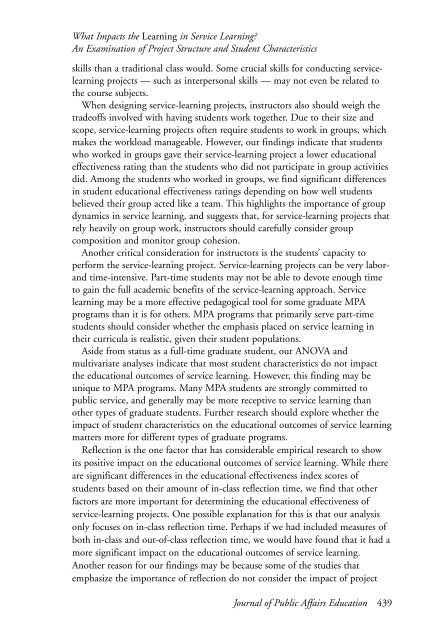JOURNAL OF PUBLIC AFFAIRS EDUCATION - National ...
JOURNAL OF PUBLIC AFFAIRS EDUCATION - National ...
JOURNAL OF PUBLIC AFFAIRS EDUCATION - National ...
You also want an ePaper? Increase the reach of your titles
YUMPU automatically turns print PDFs into web optimized ePapers that Google loves.
What Impacts the Learning in Service Learning?<br />
An Examination of Project Structure and Student Characteristics<br />
skills than a traditional class would. Some crucial skills for conducting servicelearning<br />
projects — such as interpersonal skills — may not even be related to<br />
the course subjects.<br />
When designing service-learning projects, instructors also should weigh the<br />
tradeoffs involved with having students work together. Due to their size and<br />
scope, service-learning projects often require students to work in groups, which<br />
makes the workload manageable. However, our findings indicate that students<br />
who worked in groups gave their service-learning project a lower educational<br />
effectiveness rating than the students who did not participate in group activities<br />
did. Among the students who worked in groups, we find significant differences<br />
in student educational effectiveness ratings depending on how well students<br />
believed their group acted like a team. This highlights the importance of group<br />
dynamics in service learning, and suggests that, for service-learning projects that<br />
rely heavily on group work, instructors should carefully consider group<br />
composition and monitor group cohesion.<br />
Another critical consideration for instructors is the students’ capacity to<br />
perform the service-learning project. Service-learning projects can be very laborand<br />
time-intensive. Part-time students may not be able to devote enough time<br />
to gain the full academic benefits of the service-learning approach. Service<br />
learning may be a more effective pedagogical tool for some graduate MPA<br />
programs than it is for others. MPA programs that primarily serve part-time<br />
students should consider whether the emphasis placed on service learning in<br />
their curricula is realistic, given their student populations.<br />
Aside from status as a full-time graduate student, our ANOVA and<br />
multivariate analyses indicate that most student characteristics do not impact<br />
the educational outcomes of service learning. However, this finding may be<br />
unique to MPA programs. Many MPA students are strongly committed to<br />
public service, and generally may be more receptive to service learning than<br />
other types of graduate students. Further research should explore whether the<br />
impact of student characteristics on the educational outcomes of service learning<br />
matters more for different types of graduate programs.<br />
Reflection is the one factor that has considerable empirical research to show<br />
its positive impact on the educational outcomes of service learning. While there<br />
are significant differences in the educational effectiveness index scores of<br />
students based on their amount of in-class reflection time, we find that other<br />
factors are more important for determining the educational effectiveness of<br />
service-learning projects. One possible explanation for this is that our analysis<br />
only focuses on in-class reflection time. Perhaps if we had included measures of<br />
both in-class and out-of-class reflection time, we would have found that it had a<br />
more significant impact on the educational outcomes of service learning.<br />
Another reason for our findings may be because some of the studies that<br />
emphasize the importance of reflection do not consider the impact of project<br />
Journal of Public Affairs Education 439

















